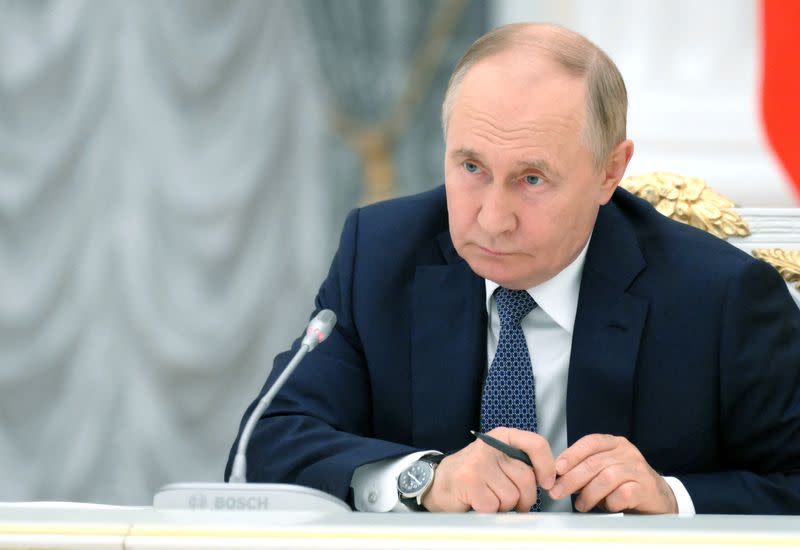Reuters
Russia vs Ukraine: the biggest war of the fake news era
Max Hunder – July 31, 2024
KHARKIV, Ukraine (Reuters) – In early April, some residents of Kharkiv received a series of chilling text messages from government officials telling them to flee the city before Russian forces surrounded it.
“Due to the threat of enemy encirclement, we urge the civilian population of Kharkiv leave the city by April 22,” said one alert, which bore the logo of the State Emergencies Service of Ukraine and mapped out safe escape routes on a slick infographic.
It was fake. Volodymyr Tymoshko knew immediately. He’s the police chief of Kharkiv region and would have been one of the first to find out about any official evacuation plans.
“Residents started getting these notifications en masse,” the 50-year-old told Reuters as he shared a screenshot of the alert, sent as Russian troops were massing at the border 30 km away.
“This is a psychological operation, it triggers panic. What would an average citizen think when they receive such a message?”
Disinformation and propaganda, long mainstays of war, have been digitally supercharged in the battle for Ukraine, the biggest conflict the world has seen since the advent of smartphones and social media.
Tymoshko said he received about 10 similar messages via SMS and Telegram messenger in April and early May, the weeks leading up to Russia’s offensive in northeastern Ukraine that began on May 10 and opened up a new front in the war.
A Ukrainian security official, who requested anonymity to discuss sensitive matters, said the Russians frequently sent large numbers of text messages from devices attached to an Orlan-10 long-range reconnaissance drone which can penetrate dozens of kilometres into Ukrainian airspace.
The devices, known as Leer-3 systems, imitate cellular base stations that phones automatically connect to in search of coverage, he added.
The phone barrage was accompanied by a social media blitz as Russian troops advanced on Kharkiv, according Andriy Kovalenko, head of Ukraine’s Centre for Countering Disinformation (CCD), a branch of the national security council.
The average number of social media posts classed as disinformation about the war by Ukrainian authorities spiked to over 2,500 a day when the Kharkiv offensive began in May, up from 200 a day in March, data compiled by the CCD shows.
The CCD chief told Reuters that Ukrainian intelligence had assessed that disinformation campaigns were primarily carried out by Russia’s FSB security service and military intelligence agency, commonly known as the GRU.
Russia’s foreign ministry and the FSB didn’t respond to a request for comment on the Ukrainian assertions, while Reuters was unable to contact the GRU.
Moscow has accused Ukraine and the West of unleashing a sophisticated information war against Russia, using the West’s major media, public relations and technology assets to sow false and biased narratives about Russia and the war.
The Ukrainian security official acknowledged his country used online campaigns in an attempt to boost anti-war sentiment among Russia’s population, although he characterised this effort as “strategic communications” to spread accurate information about the conflict.
BOTS AND MICROTARGETING
Reuters interviewed nine people with knowledge of the information and disinformation war being waged in parallel with battlefield operations, including Ukrainian officials, disinformation trackers and security analysts.
The Ukrainian security official who requested anonymity said that since the full-scale invasion of 2022, intelligence agencies had shut down 86 Russian bot farms located in Ukraine which controlled a collective 3 million social media accounts with an estimated audience reach of 12 million people.
Such facilities are rooms filled with banks of specialised computing equipment that can register hundreds of fake accounts daily on social media networks to pump out false information, the official added, citing one farm that was found by security services in the city of Vinnytsia in central Ukraine last year.
Kovalenko said that at present, the most significant sources of online Russian disinformation were TikTok in Ukraine and Telegram in Europe. Both are widely used in Ukraine.
He said that earlier this year, TikTok had shut down about 30 of the 90 accounts that Ukraine had flagged as Russia-affiliated disinformation spreaders, adding that new accounts often popped up to replace those taken down.
TikTok told Reuters its guidelines prohibited false or misleading content, adding that it had closed down 13 covert influence networks operating from Russia in recent years.
“We prohibit and constantly work to disrupt attempts to engage in covert influence operations by manipulating our platform and/or harmfully misleading our community,” a spokesperson said.
Disinformation networks are groups of accounts controlled by the same entity, and often used to push a coordinated narrative.
Telegram said it was developing a tool to add verified information to posts.
“It is Telegram’s belief that the best way to combat misinformation is not with censorship but with easy access to verified information,” a spokesperson added.
Kharkiv Mayor Ihor Terekhov told Reuters that the Russians were trying to sow panic and distrust, citing an example of social media posts claiming the main road to Kyiv was being resurfaced so that the mayor could flee faster when the Russians came – something he dismissed as a lie.
“They are trying to frighten the population so that people feel uncomfortable and leave the city,” he said in an interview in Kharkiv in late May.
By that time, the frontlines of the conflict in the northeast had stabilised about 20 km from the edge of the city after the Russian offensive had initially gained territory to the north before being blunted by Ukrainian reinforcements.
Maria Avdeeva, a Kharkiv-based security analyst who focuses on Russian disinformation, showed Reuters an infographic map, bearing Ukraine’s state emblem of a trident, posted on Facebook in early April – around the same time as police chief Tymoshko was sent a different evacuation map in a direct Telegram message.
Unperturbed by a loud explosion from a glide bomb a few kilometres away, she explained how the map and accompanying text included fake road closures and claims that missile strikes were expected in specified areas around the city soon.
Microtargeting – which analyses people’s online data to target particular individuals and audiences with specific messages, much like targeted advertising – is complicating the CCD’s task of tracking influence campaigns and countering false narratives, Kovalenko said.
“This activity is notably very tactical,” said John Hultquist, chief analyst at U.S. cybersecurity firm Mandiant, referring to Russian disinformation campaigns in Ukraine.
“We’ve seen targeting all the way down to the Ukrainian soldiers in the trenches.”
AIRSTRIKE TAKES OUT TV TOWER
Ukrainians are particularly vulnerable to digital disinformation; more than three-quarters of the population get their news from social media, far more than any other source of information, according to a study commissioned by USAid in 2023.
That is considerably higher than in any of the 24 European countries surveyed by a 2024 Reuters Institute for the Study of Journalism report, which averaged a rate of 44%.
In late April, as Moscow’s forces massed on the border near Kharkiv, a Russian airstrike took out Kharkiv’s main television tower, hindering the city’s access to information.
Dramatic footage obtained by Reuters showed the main mast of the television tower breaking off and falling to the ground.
While the Kharkiv offensive led to a significant spike in disinformation activity, there have been similar Russian campaigns over the course of the war, according to the people interviewed.
The head of the CCD highlighted a Russian campaign in October 2023 aimed at driving home the idea that Ukraine was facing a tough winter and defeat in the war.
Osavul, a Ukrainian disinformation tracking company, showed Reuters its data for this campaign, which it called “black winter”. It counted 914 messages posted by 549 actors which collectively received nearly 25 million views.
Nonetheless, according to Kovalenko, the sheer scale and frequency of Russian influence operations meant Ukrainians were becoming more suspicious of the information they receive, blunting their impact.
The disinformation push during Russia’s initial advance towards Kharkiv at the start of the invasion in 2022 – when they got much closer to the city – contributed to the panic and shock that led to hundreds of thousands of residents fleeing, several officials and experts said.
This time around, only a small number left Kharkiv, even though the amount of disinformation messaging aimed at the city was double the level in March 2022, according to CCD data.
Despite the near-daily missiles and bombs falling on the city – attacks that intensified this May – 1.3 million people remain, according to Kharkiv Mayor Terekhov, roughly the same as before Russia’s latest military incursion in the region.
The comparative lack of panic also reflects Ukrainians’ increasing familiarity with living under attack.
Reuters spoke to nearly two dozen Kharkiv residents in the second half of May, when the city was being hit by several bombs or missiles a day.
Most said they felt no desire to leave and shrugged off the danger, saying they had become used to it. Several said they had stopped following the news.
“This is a psychological mechanism, we get used to danger,” Kharkiv-based psychologist Iryna Markevych said.
In late May, Reuters correspondents dived to the ground for cover when they heard the whistle of a guided bomb piercing the air. Seemingly unfazed, mothers with pushchairs continued to stroll through the park and people bathed at a public fountain.
Yulia Oleshko, 55, a nanny pushing a buggy in a central Kharkiv park, said the best way to get through the nightmare was to simply focus on getting on with everyday life.
“Yesterday I was thinking: walking around Kharkiv is walking around a minefield … but I try not to dwell on these thoughts of fear, otherwise one might fall into depression,” she said.
“We abstract ourselves, otherwise we won’t survive.”
(Reporting by Max Hunder; Editing by Mike Collett-White and Pravin Char)













